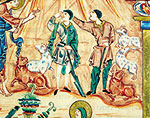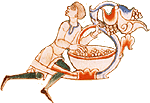![]() Livestock and crops
Livestock and crops
The
staple foods produced were cereals, grown in all localities in the recently
cleared plains  and hedgerow country. The main grain crops in Normandy were
corn (wheat) and barley, which could also be turned into bread, but was used
as well to produce the basic beverage, "cervoise" or barley beer.
Stock rearing was common everywhere in fringe areas (on the edge of
forests or on moorland) and on land left uncultivated after the harvest, where
the right to collective grazing became an established Norman custom. Western
Normandy would appear to have gone in for a degree of specialisation in
farming cattle in semi-liberty (the texts mention the vaccariae,
cowsheds) and horses, needed for transport, tillage and war. Normandy was
famous for her cavalry.
and hedgerow country. The main grain crops in Normandy were
corn (wheat) and barley, which could also be turned into bread, but was used
as well to produce the basic beverage, "cervoise" or barley beer.
Stock rearing was common everywhere in fringe areas (on the edge of
forests or on moorland) and on land left uncultivated after the harvest, where
the right to collective grazing became an established Norman custom. Western
Normandy would appear to have gone in for a degree of specialisation in
farming cattle in semi-liberty (the texts mention the vaccariae,
cowsheds) and horses, needed for transport, tillage and war. Normandy was
famous for her cavalry.
The climate was mild enough to allow the growing of vines
introduced by the Romans. Regions specialising in this production were the
Seine valley, the area east of Caen – around Argences and Cesny-aux-Vignes
– and the Avranches area. Normandy wine was even exported to England, but
under the Plantagenets it was surpassed by the wines of the Loire and
Aquitaine. Wine was to found everywhere, for it was the noble drink and was
needed for liturgical purposes too. There were vineyards in Caen within the
enclosure of the village of La Trinité Abbey, and even inside Caen Castle!
Cider on the other hand, which appeared during this period, was viewed as a
beverage for everyday. Apple-tree grafting techniques had not yet been
mastered properly and cider did not become the Normans' usual tipple until the
end of the Middle Ages.
– around Argences and Cesny-aux-Vignes
– and the Avranches area. Normandy wine was even exported to England, but
under the Plantagenets it was surpassed by the wines of the Loire and
Aquitaine. Wine was to found everywhere, for it was the noble drink and was
needed for liturgical purposes too. There were vineyards in Caen within the
enclosure of the village of La Trinité Abbey, and even inside Caen Castle!
Cider on the other hand, which appeared during this period, was viewed as a
beverage for everyday. Apple-tree grafting techniques had not yet been
mastered properly and cider did not become the Normans' usual tipple until the
end of the Middle Ages.
Intensive farming reduced the acreage of woodland in favour
of tilled land. However the woods could not be done away with altogether, being
needed as a training ground for warriors hunting game , and for firewood, building
materials, and other timber in a region looking out to sea where
shipbuilding was a thriving trade. The forests were therefore governed by a
strict system of laws. The needy who had fallen by the wayside of technical
progress lived there on the fringe, gathering and poaching, as at Le Neubourg,
in the Eure department.
, and for firewood, building
materials, and other timber in a region looking out to sea where
shipbuilding was a thriving trade. The forests were therefore governed by a
strict system of laws. The needy who had fallen by the wayside of technical
progress lived there on the fringe, gathering and poaching, as at Le Neubourg,
in the Eure department.
The produce of the sea was another major resource. Salt was extracted from the salt marshes of the Cotentin and around Avranches. Fishing, particularly herring fishing, seems to have been an important activity, and the seafarer's vocabulary preserved many expressions of Anglo-Scandinavian origin. In addition, Normans from the Cotentin to the Pays de Caux went whaling.